 La Cuidad Perdida
La Cuidad Perdida Santa Marta & DumPster Kitty
 TINY guy
TINY guy 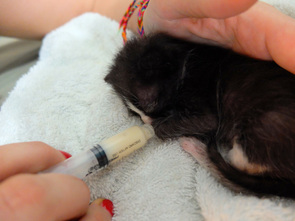
It was amazing that after just a few hours with us Charles started to become more energetic, his fur was clean and fuzzy and soft, and didn’t smell like piss anymore. Even his eye started to get better; when he napped his swollen eye was under his head, it must have pushed on his eye enough to squeeze so much puss out. So much. It was really gross but we wiped it up and tried to clean his eye with water and a towel, even more and more puss came out. So so much.
The cleaning lady had planned to take the kitten home that evening so we were patiently waiting and continuing to feed and clean him up when necessary, but when we decided to see what was taking her so long we found out that she'd already left! This wasn’t a good sign. The clerk at the front desk called her up and found out that she had simply forgotten but would for sure take him the next day.
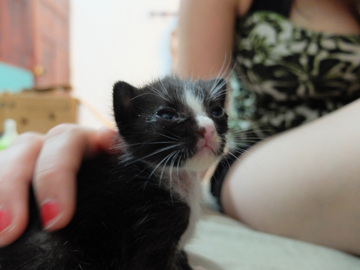 He opened his eyes!
He opened his eyes! 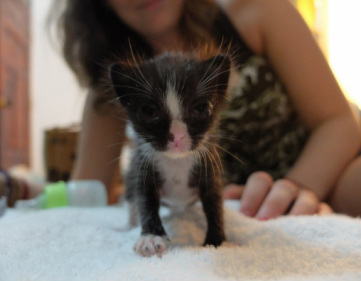 Charles doing some exploring
Charles doing some exploring The rest of the day was pretty boring; we packed our bags for the trek to leave the next morning, watched a movie and hung out. We were both eager to get out of the gross city.
La Ciudad Perdida
The Hike
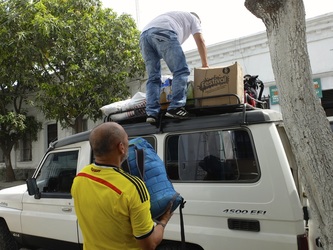 Packing our gear on the landrover
Packing our gear on the landrover 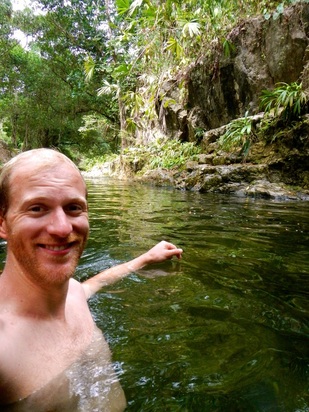 Swimming hole #1 of 4578975
Swimming hole #1 of 4578975 At one point the group of English guys started screaming and running around ahead of us. When we caught up we found out that a snake had jumped straight at one of the guys from an outcrop beside the trail. Luckily, it had missed and hit the ground and then coiled up facing them ready to lunge, finally changing its mind and slithering away into the bush. Jose had his machete out and was ready to fight. He told us the name of it but I forget, but he did say it was a deadly snake. He told us that no one has ever died from snakebite on this trek, but people have been bitten. You have 8-10 hours to get back to Santa Marta if you get bitten, and he says they usually will put the person on a mule to get back to Machete pretty quickly where a vehicle would meet you and take you back to Santa Marta.
 Hammocks for the first night
Hammocks for the first night 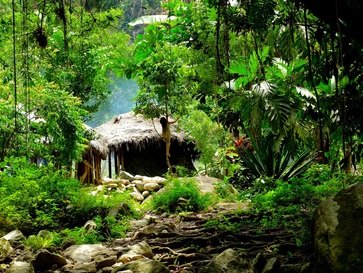 Kogi girl picking fruit outside of the villiage
Kogi girl picking fruit outside of the villiage 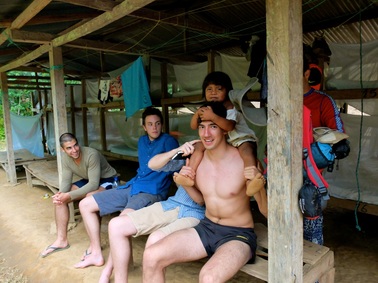 Ari harassing the English guys
Ari harassing the English guys 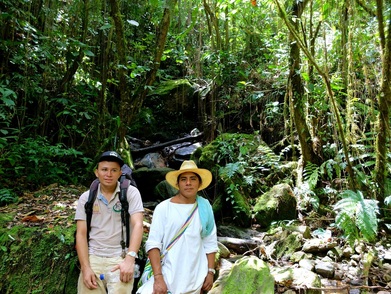 Jose (left) and another guide from the Kogi group
Jose (left) and another guide from the Kogi group 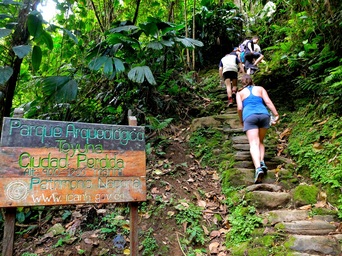 Starting our 1200 step climb to La Cuidad
Starting our 1200 step climb to La Cuidad La Ciudad Perdida (the Lost City)
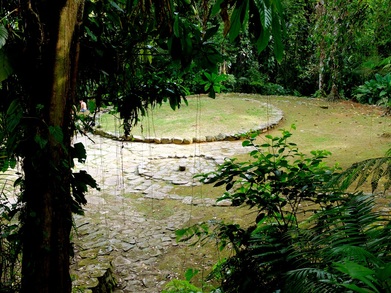 The greeting area before the final climb up
The greeting area before the final climb up 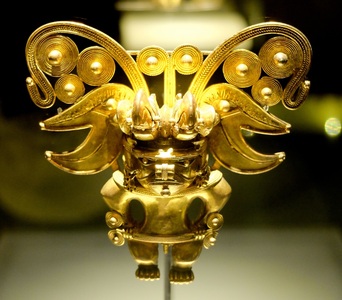 Gold figure now at the Gold Museum in Bogota Gold figure now at the Gold Museum in Bogota La Ciudad Perdida was found only in 1973, by two brothers who were known robbers and hunters. They stumbled upon it randomly, during a time when the larger area was being used for marijuana crops and people were desperately poor. The brothers were looking for crops or people to rob and they found La Ciudad Perdida. They found gold artifacts just laying around, and figured out that many were buried as well. They took what they could and sold it all in Santa Marta that year. They became rich and famous, but they would not tell anyone where they had found their treasure. Of course, the next time they returned to La Ciudad Perdida they were followed, and slowly word began to spread about how to get there. Groups of two, three and four would set out to find La Ciudad Perdida (at the time known as “Infeirno Verde" (Green Hell). Groups of cousins, brothers, and friends would make the trek in, and after they'd gathered a bunch of gold, clay artifacts and gems, greed would often turn them against one another, leaving the last one standing to take everything to Santa Marta and cash out. This went on for several years until 1981 when the Colombian Government was finally able to claim the site and prevent further theft and death. They cleaned up the many dead bodies from the area and sent in archeologists to study and repair the site. The first tourists visited the ruins later that year. Unfortunately by the time the Colombian Government claimed the site, over 80% of the artifacts had been looted and a lot of damage had been done. The other 20% of artifacts recovered by archeologists have been brought to El Museo de Oro in Bogota but by far the nicest and most interesting things have been long gone and will probably never be found. (I wonder if any of those archeologists kept anything for themselves? I mean, no one would know…) |
| If people from surrounding towns came and wished to talk to someone important who lived in La Ciudad, they would be required to bring a gift of food, gold, pottery or gems. The receiving people would decide if it was sufficient and would let them pass on up the main stairs. |
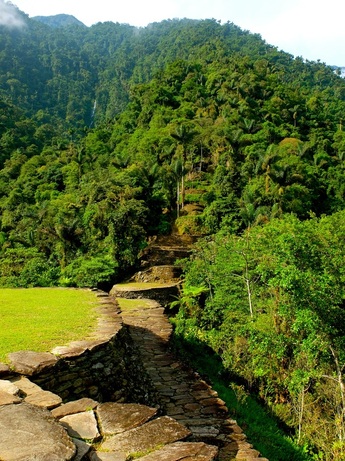 From the centre of La Cuidad looking farther in
From the centre of La Cuidad looking farther in 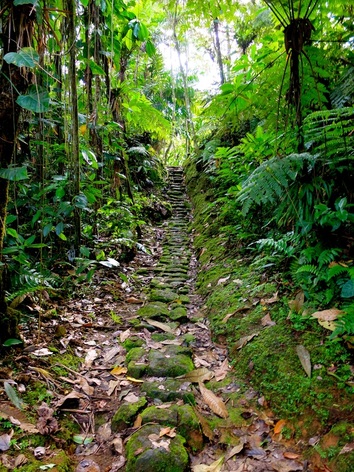 One of the many pathways between "towns"
One of the many pathways between "towns" The Hike Back
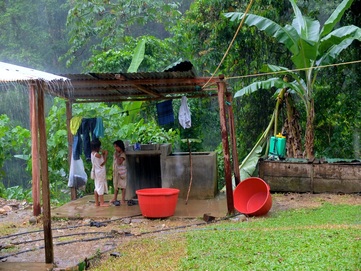 Two Kogi girls hiding from the rain
Two Kogi girls hiding from the rain We had another delicious dinner and then Jose sat down and told us some stuff about the indigenous people that currently live in the area, and also explained the process of making cocaine since we'd asked a few days before. Again Andrew and I translated to English for the group, but we’re pretty sure we understood most of what Jose was saying.
The Very Interesting Kogi People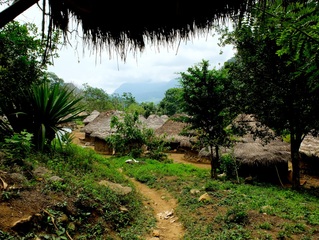 A Kogi villiage A Kogi villiage The Kogi people that live in the area now are probably descendants from the Tairona people. They still have fairly strong culture, though of course, some of the more contacted tribes have been slowly losing some of theirs. Women are the hardest working gender in the Kogi communities. They do all of the fruit and vegetable harvesting, cooking, weaving of baskets and clothing, and they crush seashells and dry coca leaves for the men. The men essentially just chew coca leaves all day long with the crushed seashell powder, meditating to communicate with mother nature and contemplate life. They carry around a pouch (called a "poporo") that contains crushed seashells and a stick they use to get powder out of the pouch. After every use, the stick gets a little bit of saliva on it and to clean it off, the men rub the end of the stick onto the outside of their poporo (which is made out of a dried vegetable kind of like a zucchini). Over time the outside of the poporo gets coated in a greyish-whitish layer of old saliva and seashell powder. It is considered the man’s personal diary, and he never leaves home without it (see Badass Bogota blog post for more on this). The men are responsible for meditating with "the mother" (mother nature), finding a plot of land before the age of 19, and planting fruits and vegetables. By the time women have their first period, they must start bearing children. Many women have 10-15 children. It is normally one man and one woman in a family, however Mamas (respected men of power, similar to Shamans) can have two or three women (but they have to spend their first 9 years of life in a dark cave being conditioned to become a Mama). The Kogi people mostly eat vegetables and fruits, but occasionally if someone hunts something they will eat meat (monkey, sloth, armadillo, caiman) or fish. I asked how many children typically stay in the communities and how many end up leaving the tribes for the city and western culture. Apparently not too many leave, but occasionally some will to attend universities, but once someone chooses to leave, they may never return. Of all of the indigenous people in Colombia, only 30% live traditionally. It was nice to hear that not too many are currently tempted by Western Culture anymore (though 70% is very high). |
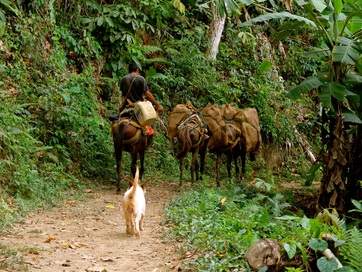 Thank you, Mules, for carrying our food!
Thank you, Mules, for carrying our food! In the morning we woke, ate and left by 6:00am. We were hiking all the way back to Machete (the first two days put together) by lunchtime. There was much more downhill than up, however two of the uphills were very very big! I was doing alright the whole time, finding the pace fairly comfortable. But Andrew and three of the English guys were struggling with bad, muy malo diarrhea They were absolutely miserable. Near they end I stuck back with Andrew while the rest took off ahead, I started thinking I might have to carry him, but he was doing alright, considering he'd had the shits since the morning we left Santa Marta. We arrived by lunchtime after a quick stop in the swimming hole 30min out of town. Lunch was good for me but only half of the people could eat. Everyone was pretty exhausted though, including me. We were now the stinky people on the other side of the restaurant watching the new people arriving and getting ready for go.
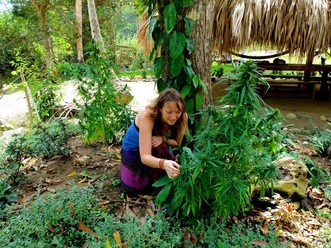 Hint: This is why he recommended it
Hint: This is why he recommended it Thanks for sticking through my long post! Until next time, keep bein' chili!
~Chelsea
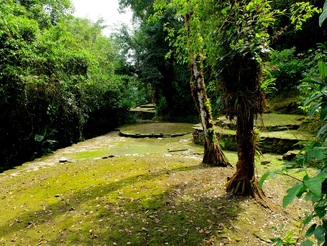
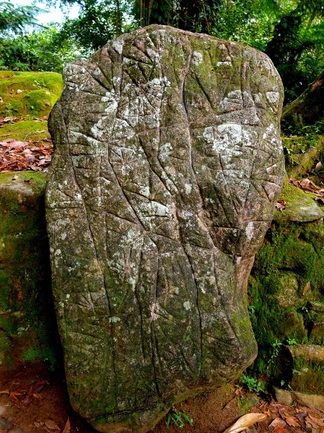
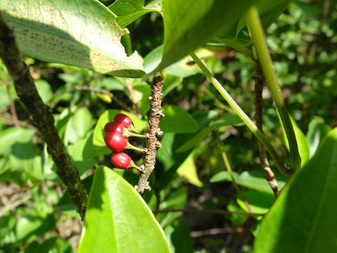
 RSS Feed
RSS Feed